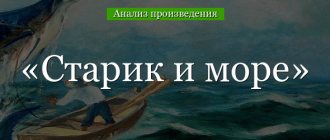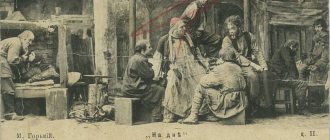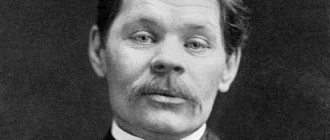“Features of M. Gorky’s early work”
1. General characteristics of early creativity.
2. The main themes of the period. 3. The theme of human freedom using the example of M. Gorky’s stories “Makar Chudra” and “Old Woman Izergil”. 4. Two principles in the worldview of M. Gorky. 5. “People of the bottom” in the writer’s work. 6. Landscape as a way of displaying harsh reality. I came into the world to disagree. V. G. Korolenko
At the turn of the 19th and 20th centuries, the name of M. Gorky became popular not only in our country, in Russia, but also abroad. His fame was equal to such literary geniuses as A. P. Chekhov, L. N. Tolstoy, V. G. Korolenko. The writer tried to draw the attention of readers, writers, critics and public figures to the philosophical and aesthetic problems of life. It was these views of M. Gorky that were reflected in his early works.
The beginning of M. Gorky’s creative career coincided with that period of time when man himself, in essence, completely devalued, was constantly humiliated, and simply became a “slave of things.” This situation and understanding of man forced the writer in all his works to constantly and persistently search for those forces that could liberate the people. ) For the first time, the reader saw M. Gorky’s story “Makar Chudra” in 1892, which was published in the newspaper “Caucasus”. Then his works began to appear in other printed publications: the Kazan newspaper “Volzhsky Vestnik”, the Nizhny Novgorod newspaper “Volgar”. In 1895, M. Gorky wrote such famous works as “Chelkash”, “Old Woman Izergil”, “Song of the Falcon”. In 1897, the writer already collaborated with the capital’s newspapers “Russian Thought”, “Novoe Slovo”, “Severny Vestnik”.
Let hell burn in my blood And my heart cry angrily [in it!] Empty! Still live
And if your hands can, strike! Beat the darkness that shackles everything around.
The writer addresses a new reader from a people “inquisitive and greedy for life.” He belongs to those people who are dissatisfied with their contemporary reality, existing injustice and are trying in every possible way to change their lives. Thus, the main themes of M. Gorky’s early work are the theme of the relationship between good and evil, strength and weakness, freedom and necessity.
The leading theme of the writer is the theme of resistance to reality. It is revealed through the images of many heroes who confront reality, do not obey general rules, strive to find the truth and gain freedom. These were the heroes of M. Gorky’s brilliant works “Makar Chudra” and “Old Woman Izergil”.
In the story “Makar Chudra,” the hero, an old gypsy, denies the foundations of that life that dooms a person to a slave existence. This hero is a brave man, striving for freedom and changing life for the better.
In “Old Woman Izergil” this same theme of freedom becomes more complex. There are already two paths to freedom shown here. Danko gives himself completely to people, he strives to make them free. The hero dies having warmed others with his heart; it is this great love for people that can work miracles. Such a manifestation of a strong personality in the writer’s work is visible in many of his heroes, for example, Falcon (“Song of the Falcon,” 1895), Burevestnik (“Song of the Burevestnik,” 1901).
But if the path to gaining freedom is chosen incorrectly, then this can lead to completely the opposite result. In the image of Larra the half-man (the son of an eagle and an earthly woman), M. Gorky shows the highest degree of human pride and love of freedom. He “wanted to have everything and keep himself whole” by committing a crime - the murder of a girl, for which he was expelled from society. It would seem that Larra has acquired the long-awaited freedom, but freedom at the cost of other people’s misfortune brings only loneliness, melancholy and emptiness: “At first the young man laughed after people. laughed, remaining alone, free, like his father. But his father was not a man. And this one was a man.” And in the end there is nothing left of Lara, only melancholy. The sage was right when he said that “the punishment is in himself.”
M. Gorky’s worldview itself can be divided into two principles, which develop in the individual himself. The first is the desire to understand the truth of life, although sometimes it is cruel and unfair. The second principle is the desire to escape from this truth and escape from it into some romantic, saving dreams. For the writer, these two positions are expressed in the clash of the different characters of the heroes, and they are absolutely opposite in relation to each other. Such contrasting heroes include Lara and Danko, Snake and Falcon, Gavril and Chelkash. It is in the dialogue between two such different heroes that the inconsistency of the world itself is revealed. The search for truth is complicated by the fact that, on the one hand, the heroes always strive to be truthful, both to themselves and to life itself. But on the other hand, they see how difficult it is for many people to hear and perceive the truth. So in the play “At the Bottom” there is not one hero who would proclaim the truth. Here she is born from the many voices of heroes: Luke, Mite, Satin, Ash.
The theme of “former people” occupies an important place in the work of M. Gorky. These are people who belong to the very bottom of society, and at the same time they have truly high aesthetic qualities. This is Chelkash in the story of the same name from 1895. This character is distinguished by his humanity, open soul and independence. According to M. Gorky, tramps are “extraordinary people” for him. The writer saw that they live much worse than “ordinary people”, but at the same time they feel much better than them, since they are not greedy, do not strangle each other and are not engaged only in accumulating money.
In his early works, to reveal the general color, emotional tension and strong-willed characters of the characters, the writer uses the technique of describing the landscape. Almost every work of M. Gorky contains: the splash of waves, the sound of the wind, the rustling of bushes and trees, the rustling of leaves. Such epithets help the reader understand all the diversity of our world, all its colors. In the early work of a writer, it is difficult to draw the line between reality and fiction. M. Gorky on the pages of his books creates a certain artistic world that is unique to him. The reader is constantly faced with images of the elements (a raging sea, steep cliffs, a dormant forest), then with animals personifying man (Falcon, Petrel), and most importantly with heroic people acting at the call of the heart (Danko). All this was the innovation of M. Gorky - the creation of a new, strong and strong-willed personality.
Source
Training and beginning of literary activity
In Gorky's life, only two years were devoted to studying at the Nizhny Novgorod School. Then, due to poverty, he went to work, but was constantly engaged in self-education. 1887 was one of the most difficult years in Gorky's biography. Due to the troubles that beset him, he tried to commit suicide, but nevertheless survived.
Traveling around the country, Gorky propagated the revolution, for which he was taken under police surveillance and then arrested for the first time in 1888.
Gorky's first published story, "Makar Chudra", was published in 1892. Then his essays in two volumes, “Essays and Stories,” published in 1898, brought fame to the writer.
In 1900–1901 he wrote the novel “Three”, met Anton Chekhov and Leo Tolstoy.
In 1902, he was awarded the title of member of the Imperial Academy of Sciences, but by order of Nicholas II it was soon invalidated.
Gorky's famous works include the story "Old Woman Izergil" (1895), the plays "Philistines" (1901) and "At the Lower Depths" (1902), the stories "Childhood" (1913–1914) and "In people" (1915-1916), the novel "The Life of Klim Samgin" (1925-1936), which the author never finished, and many cycles of stories.
Gorky also wrote fairy tales for children. Among them are “The Tale of Ivanushka the Fool”, “Sparrow”, “Samovar”, “Tales of Italy” and others. Remembering his difficult childhood, Gorky paid special attention to children, organized holidays for children from poor families, and published a children's magazine.
Early work of M. Gorky
M. Gorky entered literature on the verge of two historical eras; he seemed to combine these two eras in himself. The time of moral turmoil and disappointment, general discontent, mental fatigue - on the one hand, and the maturation of future events that have not yet been openly manifested - on the other, found its bright and passionate artist in early Gorky.
At the age of twenty, Gorky saw the world in such terrifying diversity that his bright faith in man, in his spiritual nobility, in his strength and capabilities seems incredible. But the young writer was inherent in the desire for the ideal, for the beautiful - here he was a worthy successor to the best traditions of Russian literature of the past.
In the story “Chelkash” (1894), the romantic image of a tramp and thief who broke with his environment (his father was one of the richest people in the village) is not at all idealized by the writer. Although in comparison with the spiritually wretched, greedy and pitiful Gavrila, Chelkash turns out to be the winner. But the opposition goes along the line of relation to property, to the essence that enslaves it. Gavrila's dream turns out to be a dream leading to slavery. “The power of darkness”, the power of money Chelkash denies. “Chelkash listened to his joyful cries, looked at his shining face, distorted by the delight of greed, and felt that he - a thief, a reveler, cut off from everything dear to him - would never be like that!”
For his stories, Gorky took earthly and real people, with all their contradictions and shortcomings.
He considered activity, the ability to act in the name of man, to be a measure of the value of the human personality. This motif can already be heard in the writer’s first story, “Makar Chudra” (1892). The story of the amazing, proud love of Loiko Zobar and Radda is a hymn to freedom. “Well, falcon,” says Makar, “do you want me to tell you a true story? And you remember it and, as you remember it, you will be a free bird throughout your life.”
Gorky's romanticism is no stranger to drama. He assumes it. The fates of the heroes of his first stories are always dramatic. But this is dramatic, giving rise to a protest against the slave position in society. Makar Chudra says at the beginning of the story to the author-narrator: “They are funny, those people of yours. They huddled together and crushed each other, and there is so much space on earth... Well, he was born then, perhaps, to dig up the earth, and to die... Does he know his will? Is the expanse of the steppe clear? Does the sound of the sea wave make his heart happy? He is a slave - as soon as he was born, he is a slave all his life, and that’s it!”
This is what worries the artist, what becomes the central idea of many of his stories of the early period. Everything was unusual in this story: the fate of the characters, their speech, their appearance, and the author’s speech. “I didn’t want to sleep. I looked into the darkness of the steppe, and the royally beautiful and proud figure of Radda floated in the air before my eyes. She pressed her hand with a lock of black hair to the wound on her chest, and through her dark, thin fingers blood oozed drop by drop, falling to the ground in fiery red stars...”
The fairy tale in verse “The Girl and Death” (published in 1917) is also imbued with faith in the power of man, in the power of action, in the power of love. The all-conquering hymn of “the joy of love and the happiness of life” - love without fear and doubt - is a vivid manifestation of that peculiarity of Gorky’s talent and his position in life, which characterizes the writer’s creative path.
In the work of young Gorky, “unsolvable” questions began to sound with renewed vigor: how to live? what to do? what is happiness? Questions that are eternal, if only because not a single generation has yet managed to avoid them.
In the fairy tale “About the Siskin Who Lied, and About the Woodpecker – Lover of Truth,” in which the writer tells a “very true story” about how “among the songbirds of that grove,” where pessimistic songs were sung and crows were considered “very wise birds” , suddenly other, “free, bold songs” began to sound, reminiscent of a hymn to reason:
… Let us ignite our hearts with the fire of our minds,
And light will reign everywhere.
Has he fallen and been defeated?
...Follow me, who dares! Let the darkness disappear!
For the writer, the important idea here is that a “spark” can be planted, faith and hope can be awakened. In this tale, the artist noted the awakening of consciousness only for a moment. In “Song of the Falcon” (1895), the death of a proud and brave bird already confirms the victory of that outlook on life, the bearer of which was the beautiful Falcon. “Earthly” is already defeated by the fact that he does not understand what flying into the sky, freedom means, and is sure that “there is only empty space there.” His “real” view of life excludes the spirituality of human existence on earth.
Features of M. Gorky's early work
1. General characteristics of early creativity. 2. The main themes of the period. 3. The theme of human freedom using the example of M. Gorky’s stories “Makar Chudra” and “Old Woman Izergil”. 4. Two principles in the worldview of M. Gorky. 5. “People of the bottom” in the writer’s work. 6. Landscape as a way of displaying harsh reality. I came into the world to disagree. V. G. Korolenko At the turn of the 19th and 20th centuries, the name of M. Gorky became popular not only in our country, in Russia, but also abroad. His fame was equal to such literary
It was these views of M. Gorky that were reflected in his early works. The beginning of M. Gorky’s creative path coincided with that period of time when man himself, in essence, completely depreciated, was constantly humiliated, and simply became a “slave of things.” This situation and understanding of man forced the writer in all his works to constantly and persistently search for those forces that could liberate the people. ) First
The hero dies having warmed others with his heart; it is this great love for people that can work miracles. Such a manifestation of a strong personality in the writer’s work is visible in many of his heroes, for example, Falcon (“Song of the Falcon,” 1895), Burevestnik (“Song of the Burevestnik,” 1901). But if the path to gaining freedom is chosen incorrectly, then this can lead to completely the opposite result. In the image of Larra the half-man (the son of an eagle and an earthly woman), M. Gorky shows the highest degree of human pride and love of freedom. He “wanted to have everything and keep himself whole” by committing a crime - the murder of a girl, for which he was expelled from society. It would seem that Larra has acquired the long-awaited freedom, but freedom at the cost of the misfortune of other people brings only loneliness, melancholy and emptiness: “At first the young man laughed after the people... he laughed, remaining alone, free, like his father.
But his father was not a man. And this one was a man.” And in the end there is nothing left of Lara, only melancholy.
The sage was right when he said that “the punishment is in himself.” M. Gorky’s worldview itself can be divided into two principles, which develop in the individual himself. The first is the desire to understand the truth of life, although sometimes it is cruel and unfair. The second principle is the desire to escape from this truth and escape from it into some romantic, saving dreams. For the writer, these two positions are expressed in the clash of the different characters of the heroes, and they are absolutely opposite in relation to each other.
Such contrasting heroes include Lara and Danko, Snake and Falcon, Gavril and Chelkash. It is in the dialogue between two such different heroes that the inconsistency of the world itself is revealed. The search for truth is complicated by the fact that, on the one hand, the heroes always strive to be truthful, both to themselves and to life itself. But on the other hand, they see how difficult it is for many people to hear and perceive the truth.
So in the play “At the Bottom” there is not one hero who would proclaim the truth. Here she is born from the many voices of heroes: Luke, Mite, Satin, Ash. The theme of “former people” occupies an important place in the work of M. Gorky. These are people who belong to the very bottom of society, and at the same time they have truly high aesthetic qualities. This is Chelkash in the story of the same name from 1895. This character is distinguished by his humanity, open soul and independence.
According to M. Gorky, tramps are “extraordinary people” for him. The writer saw that they live much worse than “ordinary people,” but at the same time they feel much better than them, since they are not greedy, do not strangle each other and are not engaged only in accumulating money. In his early works, to reveal the general color, emotional tension and strong-willed characters of the characters, the writer uses the technique of describing the landscape. Almost every work of M. Gorky contains: the splash of waves, the sound of the wind, the rustling of bushes and trees, the rustling of leaves. Such epithets help the reader understand all the diversity of our world, all its colors. In the early work of a writer, it is difficult to draw the line between reality and fiction.
M. Gorky on the pages of his books creates a certain artistic world that is unique to him. The reader is constantly faced with images of the elements (a raging sea, steep cliffs, a dormant forest), then with animals personifying man (Falcon, Petrel), and most importantly with heroic people acting at the call of the heart (Danko). All this was the innovation of M. Gorky - the creation of a new, strong and strong-willed personality.
Emigration, return to homeland
In 1906, an important event occurred in the biography of Maxim Gorky - he moved to the USA, then to Italy, where he lived until 1913. Even there, Gorky’s work defended the revolution. Returning to Russia, he stops in St. Petersburg. Here Gorky works in publishing houses and is involved in social activities. In 1921, due to worsening illness and disagreements with the authorities, at the insistence of Vladimir Lenin, he again went abroad. The writer finally returned to the USSR in October 1932.





